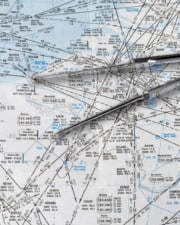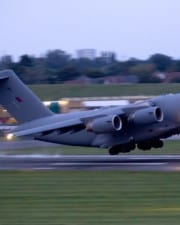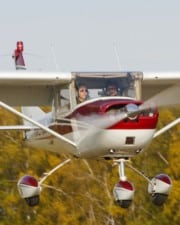Several medical factors affect pilots while flying aircraft. Most of these have to do with operating at high altitudes, or medical considerations that could affect their ability to operate the plane safely.
Table of Contents
What Is Spatial Disorientation?
Spatial disorientation, on the other hand, comes as a result of flight itself. Spatial disorientation occurs when the pilot’s senses don’t agree with the flight attitude of the aircraft. In essence, the pilot can no longer tell up from down or turns from level flight.
How Does Spatial Disorientation Occur?
Humans have evolved several highly tuned senses that keep us oriented when on land. The three primary methods we use are our visual, kinesthetic, and vestibular senses.
Our eyes are our primary tools for figuring out how we are situated. In a plane, if we can see the horizon outside, we can immediately know if we are flying straight and level or in a turn. A pilot, with a little bit of training, can also usually tell whether the plane is climbing or descending.
Our muscles also give us cues to indicate how we are moving. As we accelerate down the runway, our body gets pressed back into the seat and we can feel, using our kinesthetic sense, that we are moving forward.

Finally, our inner ears possess an amazing system for sensing motion. Fluid moves through a set of semicircular canals inside the ear, and the ear can process this motion in terms of acceleration or movement. There are three semicircular canals in each ear, so there is one for each axis of motion.
Unfortunately, all of these senses are very easily fooled when our feet leave the ground. Simply flying into a cloud renders our visual sense useless. Various G-forces during turns and climbs are confusing to our kinesthetic senses. And our inner ear’s vestibular sense has evolved to help us while walking or running, not cloud surfing in a 747.
What Flight Situations Often Lead to Spatial Disorientation?
The FAA specifically lists six illusions that can affect the vestibular sense during flight. These are common flight scenarios that will cause spatial disorientation for any kind of pilot.
The Leans
Many illusions begin with the simple act of putting the aircraft into a turn. Unlike a car, when an aircraft turns, the forces remain relatively constant. But they pull the pilot down towards the ground instead of towards the outside of the turn.
If a turn is entered very gradually, it is possible for the fluid in the ears to not move inside the semicircular canals. Any roll entered suddenly after that will reference the first turn as what feels like level flight to the pilot. The result is a pilot who believes they are flying straight and level, but are actually in a turn.
The Coriolis Illusion
A turn also causes this illusion. If in a steady turn, any head movement is easily perceived by the body as a dramatic change in flight attitude.
While the plane’s attitude doesn’t change, the pilot will believe it has and correct it. This can be a dangerous setup.
Because of the Coriolis illusion, it’s essential that pilots do not move their heads suddenly when instrument flying. If the need to move their heads to get something out of the back seat or get something off the floor, they should do so slowly and deliberately.
The Graveyard Spiral
The foreboding name of this illusion should indicate just how deadly this particular illusion can be.
Once established in a steady coordinated turn, the pilot’s body will not feel a sensation of turning. If a pilot relies on their vestibular senses to get out of the turn, they may find that they unknowingly return the plane to the original turn. Since turns result in a loss of vertical lift, the aircraft will begin to descend.
Not realizing that the plane is turning as well as descending, the unsuspecting pilot will pull back to control the altitude loss. This only results in tightening the turn into a steeply descending spiral.
The Somatogravic Illusion
Because of the natural design of the inner ear, sudden accelerations are interpreted the same way as moving one’s head back. When experiencing a rapid acceleration, for example on takeoff, a pilot may feel like they are also pitching up.
Decelerating has the opposite effect.
The Inversion Illusion
Pitching forward suddenly, for example changing from a climb to level flight, can cause a sensation much like tumbling backward or becoming inverted.
The Elevator Illusion
It isn’t just control inputs that affect aircraft flight paths. Updrafts and downdrafts can cause sudden changes in flight attitudes, especially for instrument pilots flying through clouds.
The elevator illusion comes from up and downdrafts affect the plane and pilot. The inner ear interprets these motions as climbs and descent, and the unwary pilot could easily enter an unnecessary climb or descent to correct for them.
How Does Spatial Disorientation Affect a Pilot?
Spatial disorientation, and conquering it, is one of the primary goals of learning to fly on instruments. Beginning instrument pilots spend hours working on fundamental attitude maneuvers with no other references but the flight instruments.
Flight instructors also work hard to confuse students’ senses while flying, not to make their training more difficult but to give an honest taste to what flying in instrument weather is actually like. Students must be able to recover from unusual flight attitudes quickly and effectively.

The sad truth is that many lives have been lost to spatial disorientation. As humans, we have grown and survived by trusting our natural senses.
Spatial Disorientation Prevention
Understanding these illusions and understanding how easily our senses can be fooled is the first step to prevention.
The cure for spatial disorientation is pretty easy. A pilot must always trust their flight instruments over their body’s senses.
To help accomplish this, they must possess strong enough instrument flying skills to disregard faulty instrument readings by always cross-checking every indication with multiple sources.
And they must be able to self diagnose a spatial disorientation problem. The purpose of unusual attitude or upset training is to encourage a pilot to use a reset button in instrument flying. If they begin to suspect that they have become spatially disoriented, this training is what will save their lives.
References ▾
Related Posts













